Mechanical Behaviour of Pin-Reinforced Foam Core Sandwich Panels Subjected to Low Impact Loading
Abstract
1. Introduction
2. Material and Experiment
3. Finite Element Model and Simulation
4. Design of Experiment Analysis
5. Results and Discussion
5.1. Experimental Results
5.2. Validation Procedure
5.3. Effect of Different Loading Rates
5.4. Failure Modes on FCS and PFCS Panels
5.5. ANOVA Analysis and Verification Test
6. Conclusions
Author Contributions
Funding
Institutional Review Board Statement
Informed Consent Statement
Data Availability Statement
Conflicts of Interest
References
- Pereira, A.B.; Fernandes, F.A.O. Sandwich Panels Bond with Advanced Adhesive Films. J. Compos. Sci. 2019, 3, 79. [Google Scholar] [CrossRef]
- Rahimian Koloor, S.S.; Karimzadeh, A.; Yidris, N.; Petrů, M.; Ayatollahi, M.R.; Tamin, M.N. An energy-based concept for yielding of multidirectional FRP composite structures using a mesoscale lamina damage model. Polymers 2020, 12, 157. [Google Scholar] [CrossRef]
- Abdi, B.; Azwan, S.; Abdullah, M.; Ayob, A.; Yahya, Y.; Xin, L. Flatwise compression and flexural behavior of foam core and polymer pin-reinforced foam core composite sandwich panels. Int. J. Mech. Sci. 2014, 88, 138–144. [Google Scholar] [CrossRef]
- Balıkoğlu, F.; Yıldız, M.; Demircioğlu, T.; Ataş, A.; Arslan, N. Compressive and flexural behaviour of pin reinforced marine composite sandwich beams. In Proceedings of the IV international EGE composite materials symposium (KOMPEGE 2018), Izmir, Turkey, 6–8 September 2018; pp. 272–285. [Google Scholar]
- Chauhan, S.; Sahu, S.; Ansari, M.Z. Effect of boundary support conditions on impact behavior of silicone pin-reinforced polymer sandwich composite structure. Polym. Compos. 2020, 41, 5104–5115. [Google Scholar] [CrossRef]
- Jayaram, R.; Nagarajan, V.; Kumar, K.V. Low velocity impact and compression after impact behaviour of polyester pin-reinforced foam filled honeycomb sandwich panels. J. Sandw. Struct. Mater. 2021, 1099636221998180. [Google Scholar] [CrossRef]
- Peliński, K.; Smardzewski, J. Bending behavior of lightweight wood-based sandwich beams with auxetic cellular core. Polymers 2020, 12, 1723. [Google Scholar] [CrossRef]
- Yang, B.; Wang, Z.; Zhou, L.; Zhang, J.; Tong, L.; Liang, W. Study on the low-velocity impact response and CAI behavior of foam-filled sandwich panels with hybrid facesheet. Compos. Struct. 2015, 132, 1129–1140. [Google Scholar] [CrossRef]
- Abdi, B.; Azwan, S.; Abdullah, M.; Ayob, A.; Yahya, Y. Comparison of foam core sandwich panel and through-thickness polymer pin–reinforced foam core sandwich panel subject to indentation and flatwise compression loadings. Polym. Compos. 2016, 37, 612–619. [Google Scholar] [CrossRef]
- Olsson, R.; Block, T.B. Criteria for skin rupture and core shear cracking induced by impact on sandwich panels. Compos. Struct. 2015, 125, 81–87. [Google Scholar] [CrossRef]
- Abdi, B.; Koloor, S.; Abdullah, M.; Amran, A.; Yahya, M.Y. Effect of strain-rate on flexural behavior of composite sandwich panel. In Applied Mechanics and Materials; Trans Tech Publications Ltd.: Bäch, Switzerland, 2012; pp. 766–770. [Google Scholar]
- Kaya, G.; Selver, E. Impact resistance of Z-pin-reinforced sandwich composites. J. Compos. Mater. 2019, 53, 3681–3699. [Google Scholar] [CrossRef]
- Raeisi, S.; Kadkhodapour, J.; Tovar, A. Mechanical properties and energy absorbing capabilities of Z-pinned aluminum foam sandwich. Compos. Struct. 2019, 214, 34–46. [Google Scholar] [CrossRef]
- Santhanakrishnan, R.; Samlal, S.; Joseph Stanley, A.; Jayalatha, J. Impact study on sandwich panels with and without stitching. Adv. Compos. Mater. 2018, 27, 163–182. [Google Scholar] [CrossRef]
- Virakthi, A.; Kwon, S.; Lee, S.W. A viable model for out-of-plane compressive and shear properties of Z-pin reinforced composite sandwich panels. J. Compos. Mater. 2018, 52, 3961–3972. [Google Scholar] [CrossRef]
- Han, F.; Yan, Y.; Ma, J. Experimental study and progressive failure analysis of stitched foam-core sandwich composites subjected to low-velocity impact. Polym. Compos. 2018, 39, 624–635. [Google Scholar] [CrossRef]
- Dimassi, M.A.; Herrmann, A.S. Numerical Simulation of Low Velocity Impact on Pin-Reinforced Foam Core Sandwich Panel. In Key Engineering Materials; Trans Tech Publications Ltd.: Bäch, Switzerland, 2017; pp. 673–680. [Google Scholar]
- Al-Fatlawi, A.; Jármai, K.; Kovács, G. Optimal Design of a Fiber-Reinforced Plastic Composite Sandwich Structure for the Base Plate of Aircraft Pallets In Order to Reduce Weight. Polymers 2021, 13, 834. [Google Scholar] [CrossRef]
- Khan, M.S.; Abdul-Latif, A.; Koloor, S.S.R.; Petrů, M.; Tamin, M.N. Representative Cell Analysis for Damage-Based Failure Model of Polymer Hexagonal Honeycomb Structure under the Out-of-Plane Loadings. Polymers 2021, 13, 52. [Google Scholar] [CrossRef]
- Liu, Y.; Li, M.; Lu, X.; Zhu, X. Failure Mechanism and Strength Prediction Model of T-Joint of Composite Sandwich Structure. Metals 2021, 11, 1197. [Google Scholar] [CrossRef]
- Koloor, S.; Tamin, M. Mode-II interlaminar fracture and crack-jump phenomenon in CFRP composite laminate materials. Compos. Struct. 2018, 204, 594–606. [Google Scholar] [CrossRef]
- Dimassi, M.A.; Focke, O.; Brauner, C.; Herrmann, A.S. Experimental study of the indentation behaviour of tied foam core sandwich structures. In Proceedings of the 17th European Conference on Composite Materials, Munich, Germany, 26–30 June 2016. [Google Scholar]
- Ng, T.P.; Koloor, S.; Djuansjah, J.; Kadir, M.A. Assessment of compressive failure process of cortical bone materials using damage-based model. J. Mech. Behav. Biomed. Mater. 2017, 66, 1–11. [Google Scholar] [CrossRef]
- Dhaliwal, G.S.; Newaz, G.M. Flexural Response of Degraded Polyurethane Foam Core Sandwich Beam with Initial Crack between Facesheet and Core. Materials 2020, 13, 5399. [Google Scholar] [CrossRef]
- Chen, C.; Wang, P.; Legrand, X. Effect of Core Architecture on Charpy Impact and Compression Properties of Tufted Sandwich Structural Composites. Polymers 2021, 13, 1665. [Google Scholar] [CrossRef]
- Sharei, A.; Safarabadi, M.; Mashhadi, M.M.; Solut, R.S.; Haghighi-Yazdi, M. Experimental and numerical investigation of low velocity impact on hybrid short-fiber reinforced foam core sandwich panel. J. Compos. Mater. 2021, 00219983211037388. [Google Scholar] [CrossRef]
- Najafi, M.; Eslami-Farsani, R. Design and characterization of a multilayered hybrid cored-sandwich panel stiffened by thin-walled lattice structure. Thin-Walled Struct. 2021, 161, 107514. [Google Scholar] [CrossRef]
- Virakthi, A.K.M. Z-Pinning Techniques and Modeling in Composite Laminates and X-Cor Sandwich Structures. Doctoral Dissertation, University of Maryland, College Park, MD, USA, 2018. [Google Scholar]
- Nia, A.B.; Yahya, M.; Ayob, A.; Nejad, A.F. Optimization of graded metallic foam subjected to impulsive loading through DOE approach. In Proceedings of the 2018 9th International Conference on Mechanical and Aerospace Engineering (ICMAE), Budapest, Hungary, 10–13 July 2018; pp. 295–299. [Google Scholar]
- Najarian, F.; Alipour, R.; Rad, M.S.; Nejad, A.F.; Razavykia, A. Multi-objective optimization of converting process of auxetic foam using three different statistical methods. Measurement 2018, 119, 108–116. [Google Scholar] [CrossRef]
- Azwan, S.; Yahya, Y.; Abdi, B.; Ayob, A. Loading Rate Effect on Flexural and Indentation Behaviour of Foam Core Composite Sandwich Panel. J. Teknol. 2014, 71. [Google Scholar] [CrossRef][Green Version]
- Hallquist, J.O. LS-DYNA keyword user’s manual. Livermore Softw. Technol. Corp. 2007, 970, 299–800. [Google Scholar]
- Brekken, K.A.; Reyes, A.; Berstad, T.; Langseth, M.; Børvik, T. Sandwich Panels with Polymeric Foam Cores Exposed to Blast Loading: An Experimental and Numerical Investigation. Appl. Sci. 2020, 10, 9061. [Google Scholar] [CrossRef]
- Garg, R.; Babaei, I.; Paolino, D.S.; Vigna, L.; Cascone, L.; Calzolari, A.; Galizia, G.; Belingardi, G. Predicting Composite Component Behavior Using Element Level Crashworthiness Tests, Finite Element Analysis and Automated Parametric Identification. Materials 2020, 13, 4501. [Google Scholar] [CrossRef]
- Farokhi Nejad, A.; Alipour, R.; Shokri Rad, M.; Yazid Yahya, M.; Rahimian Koloor, S.S.; Petrů, M. Using finite element approach for crashworthiness assessment of a polymeric auxetic structure subjected to the axial loading. Polymers 2020, 12, 1312. [Google Scholar] [CrossRef]
- Jiang, L.; Yang, B.; Xiao, S.; Yang, G.; Zhu, T.; Dong, D. Simulation Study of Adhesive Material for Sandwich Panel under Edgewise Compression Condition. Materials 2020, 13, 1391. [Google Scholar] [CrossRef]
- Koloor, S.; Abdullah, M.; Tamin, M.; Ayatollahi, M. Fatigue damage of cohesive interfaces in fiber-reinforced polymer composite laminates. Compos. Sci. Technol. 2019, 183, 107779. [Google Scholar] [CrossRef]
- Nejad, A.F.; Chiandussi, G.; Solimine, V.; Serra, A. Estimation of the synchronization time of a transmission system through multi body dynamic analysis. Int. J. Mech. Eng. Robot. Res. 2017, 6, 232–236. [Google Scholar] [CrossRef][Green Version]

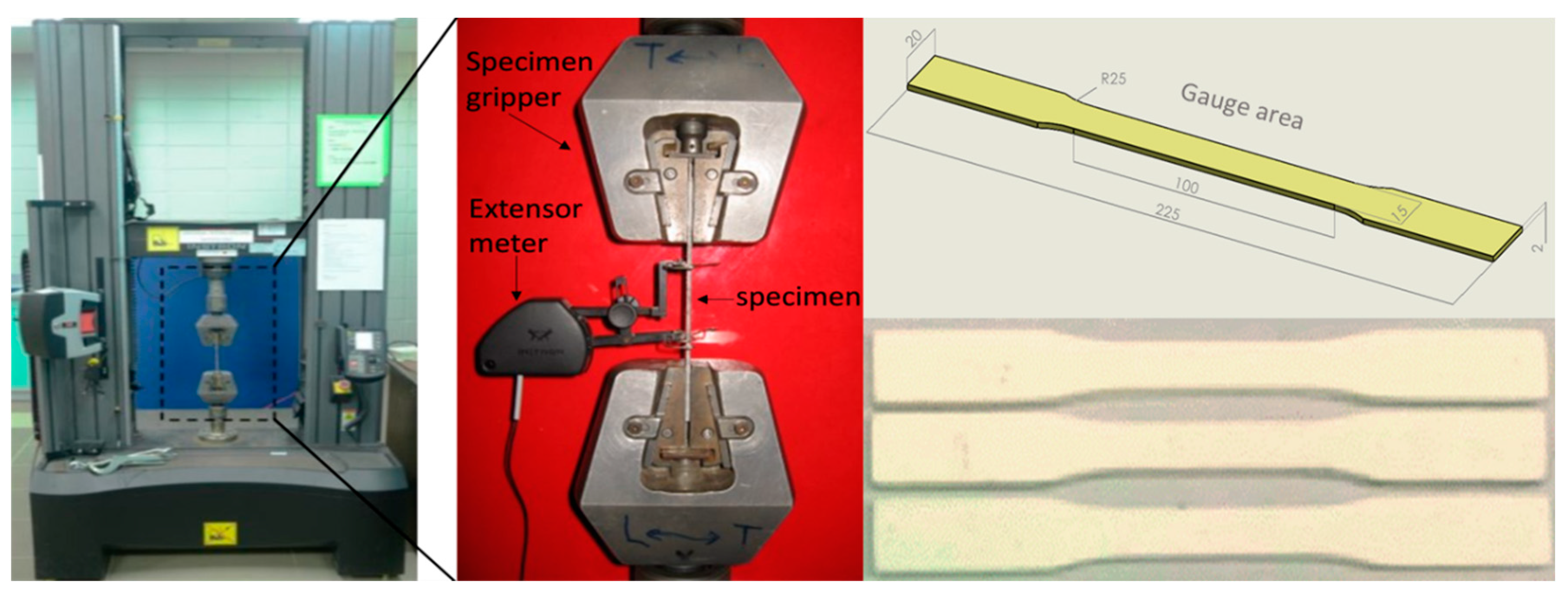

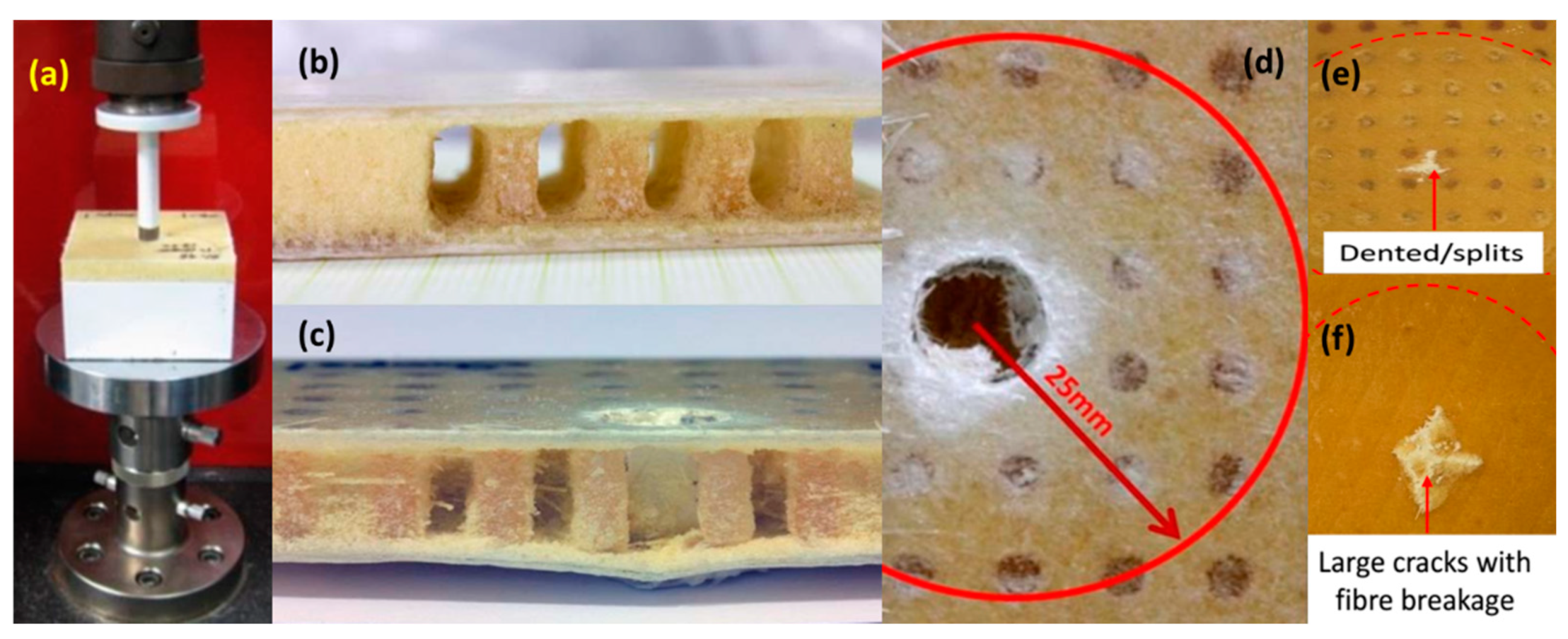
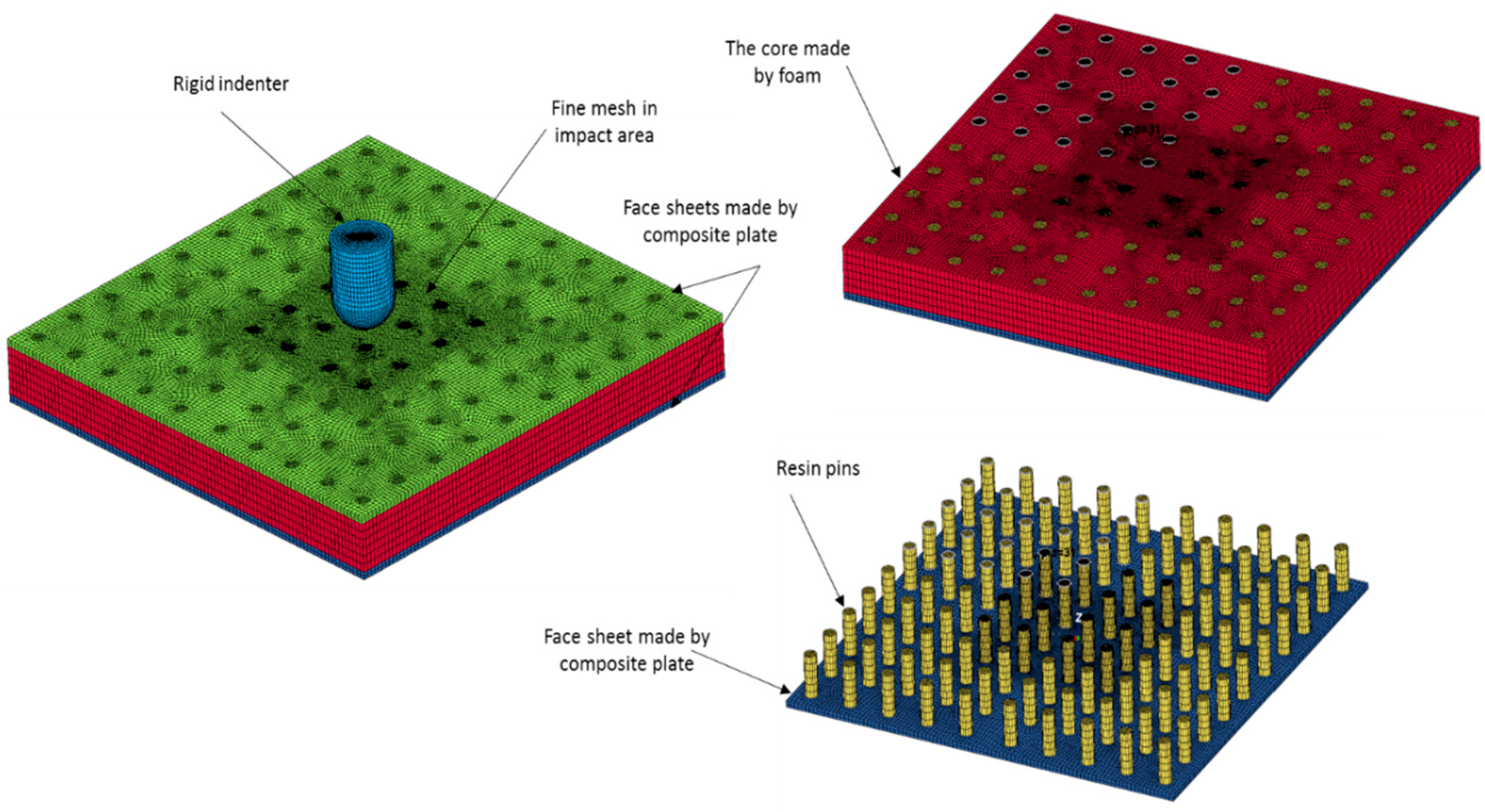

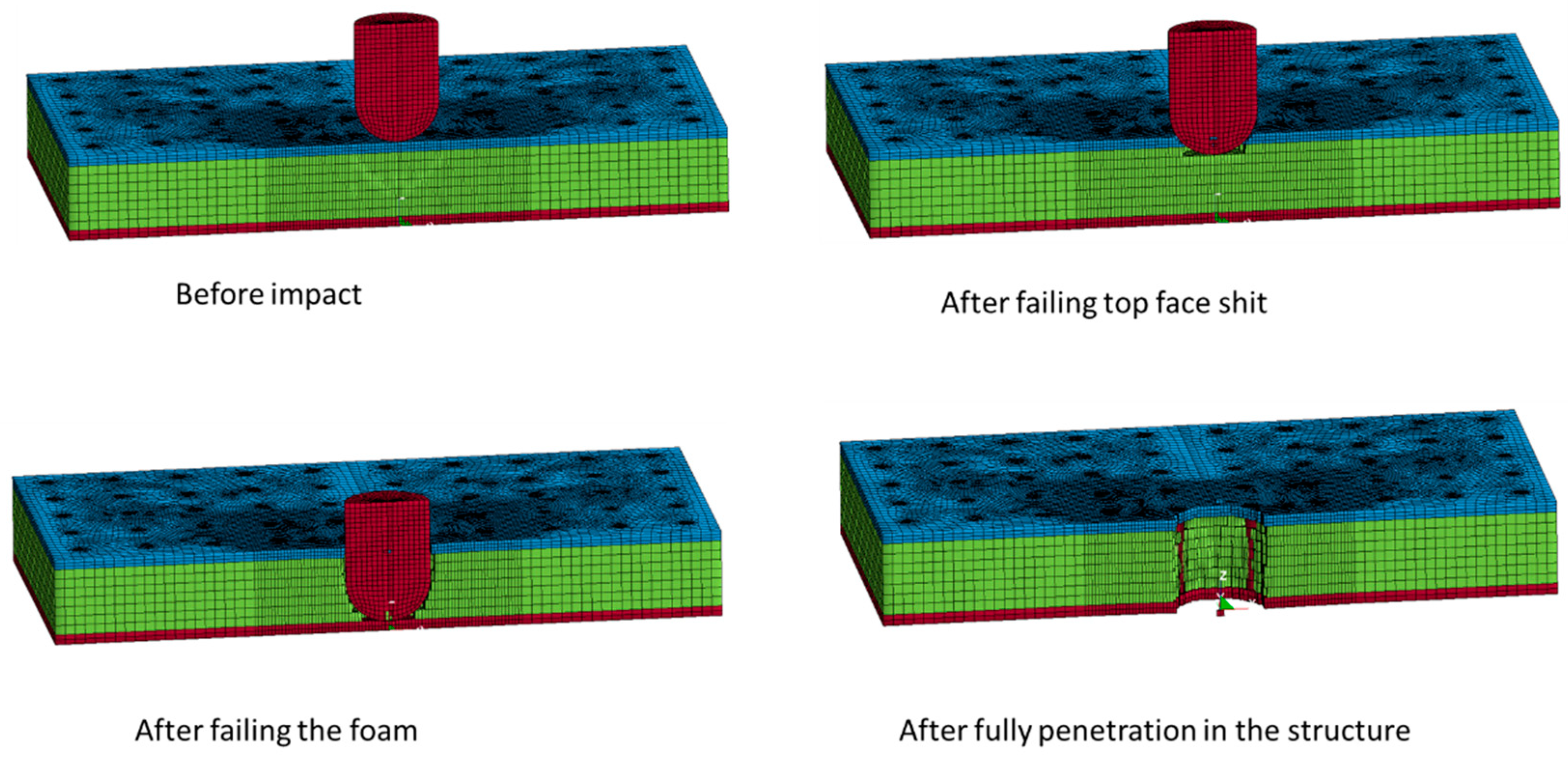

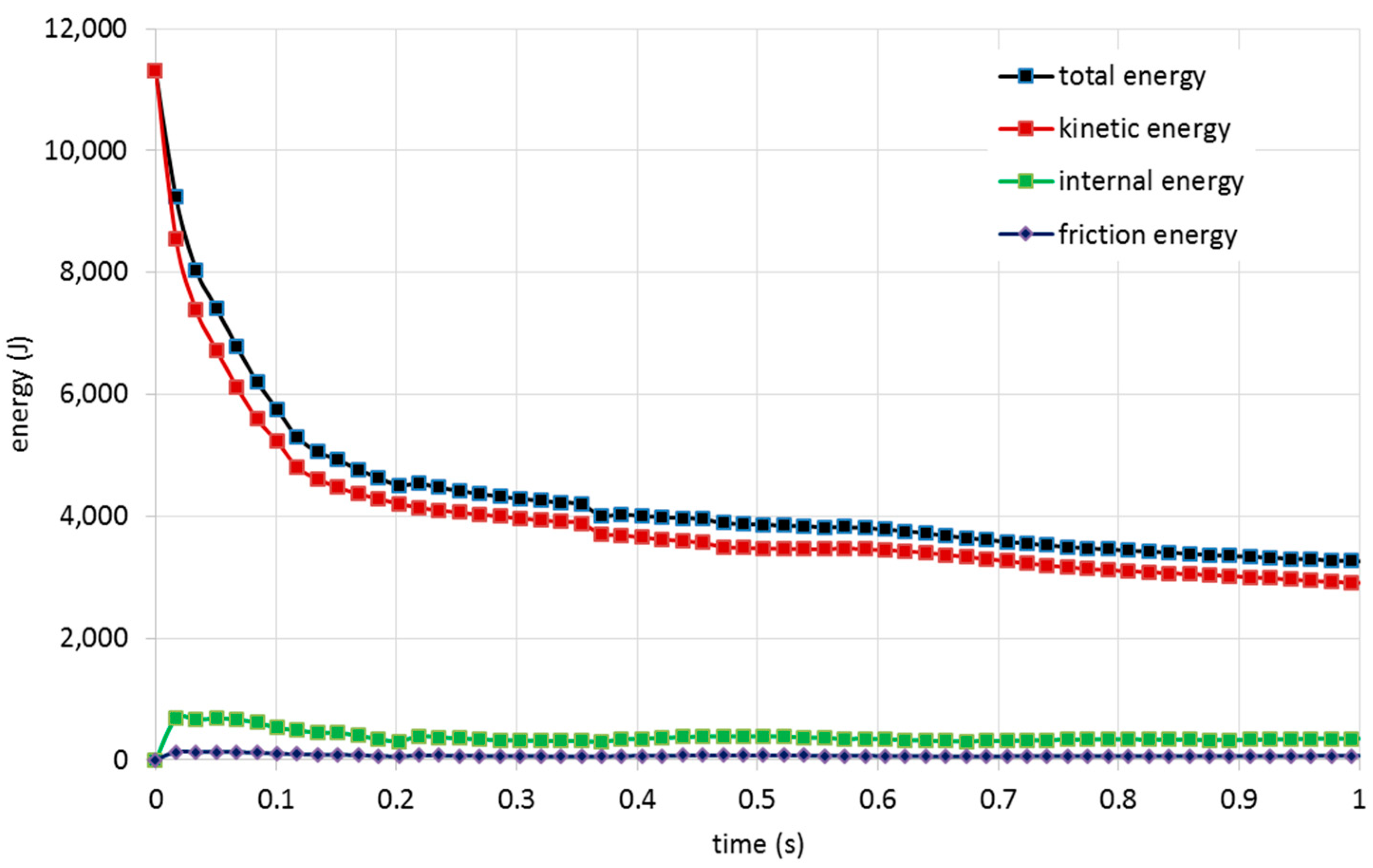
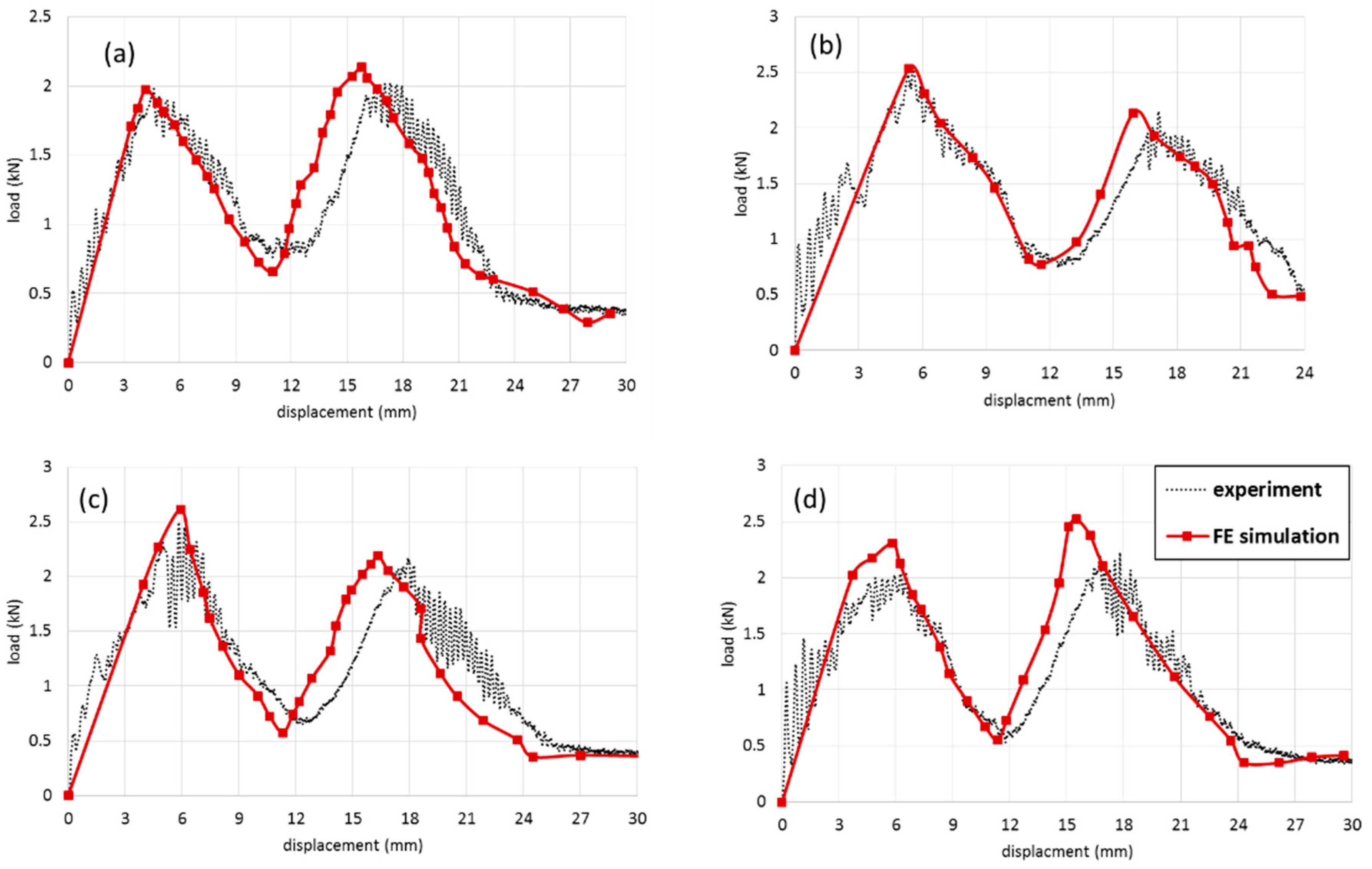

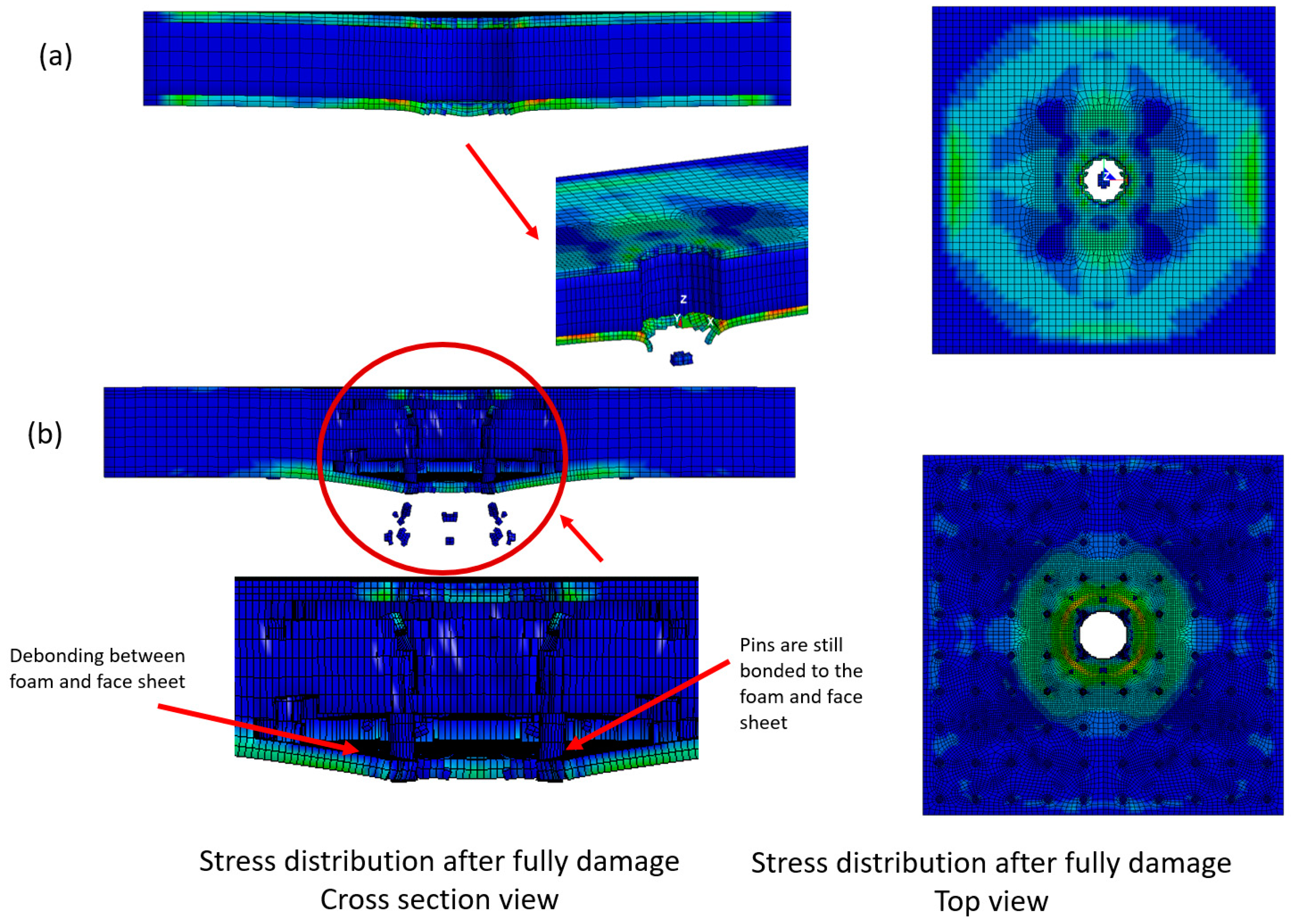


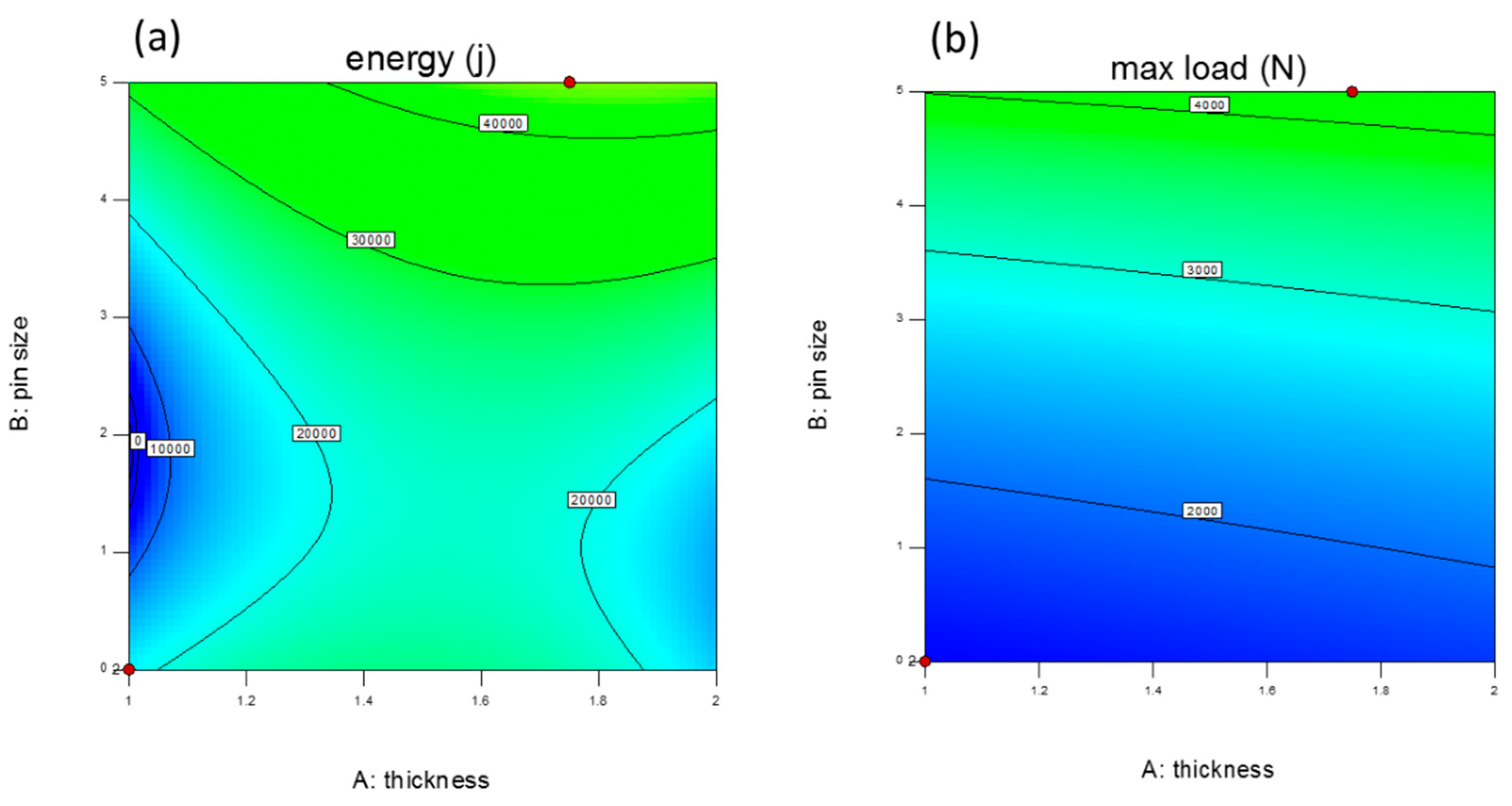
| Material | (kg/m3) | E (Gpa) | ν | ||
|---|---|---|---|---|---|
| PU foam (core) | 139.1 | 0.125 | 0.05 | 0.025 | 1.293 |
| Polyester resin (pins) | 1200 | 4 | 0.4 | 0.65 | 80 |
| Glass fiber/polyester (face sheets) | 1150 | 15.75 | 0.22 | 0.0136 | 154.1 |
| Study Type | Response Surface Randomized | |||||||||
|---|---|---|---|---|---|---|---|---|---|---|
| Design Type | I-Optimal | Runs | 24 | |||||||
| Design Model | Quadratic | |||||||||
| Factor | Name | Units | Type | Subtype | Minimum | Maximum | Coded | Values | Mean | Std. Dev. |
| A | thickness | Numeric | Continuous | 1 | 2 | FALSE | 1.000 = 2 | 1.48958 | 0.413621 | |
| B | pin size | Numeric | Continuous | 0 | 5 | FALSE | 1.000 = 5 | 2.27083 | 1.96147 | |
| C | velocity | Numeric | Continuous | 1 | 500 | FALSE | 1.000 = 500 | 173.917 | 217.173 | |
| D | impactor | Categoric | Nominal | 1 | 2 | Levels: | 2 | |||
| Response | Name | Units | Total run | Analysis | Minimum | Maximum | Mean | Std. Dev. | Ratio | Trans |
| R1 | energy | j | 24 | Polynomial | 3706.69 | 63,637.6 | 29,936 | 12,917.1 | 17.1683 | Power |
| R2 | max load | N | 24 | Polynomial | 3090.95 | 6774.3 | 3981 | 1447.55 | 22.5097 | None |
| Response | 1 | Energy Absorption | |||
|---|---|---|---|---|---|
| Transform: | Power | Lambda: | 1.98 | Constant: | 0 |
| Sum of Squares | df | Mean | F Value | p-Value Prob > F | |
| Source | Square | ||||
| Model | 1.12 × 1019 | 13 | 8.62 × 1017 | 102.49 | <0.0001 |
| A-thickness | 2.84 × 1017 | 1 | 2.84 × 1017 | 33.72 | 0.0002 |
| B-pin size | 8.69 × 1018 | 1 | 8.69 × 1018 | 1033.12 | <0.0001 |
| C-velocity | 8.53 × 1017 | 1 | 8.53 × 1017 | 101.4 | <0.0001 |
| D-impactor | 5.82 × 1017 | 1 | 5.82 × 1017 | 69.12 | <0.0001 |
| Residual | 8.41 × 1016 | 10 | 8.41 × 1015 | ||
| Std. Dev. | 9.17 × 107 | R-Squared | 0.9926 | ||
| Mean | 8.56 × 108 | Adj R-Squared | 0.9829 | ||
| C.V. % | 10.72 | Pred R-Squared | 0.8521 | ||
| PRESS | 1.67 × 1018 | Adeq Precision | 45.475 | ||
| Response | 2 | Max Peak Load | |||
|---|---|---|---|---|---|
| Transform: | Power | Lambda: | −0.83 | Constant: | 0 |
| Sum of | df | Mean Square | F Value | p-Value Prob > F | |
| Source | Squares | ||||
| Model | 2.07 × 106 | 10 | 2.07 × 105 | 18.54 | <0.0001 |
| A-thickness | 6.11 × 103 | 1 | 6.11 × 103 | 0.55 | 0.4723 |
| B-pin size | 1.76 × 106 | 1 | 1.76 × 106 | 158.14 | <0.0001 |
| C-velocity | 4.18 × 104 | 1 | 4.18 × 104 | 3.75 | 0.0749 |
| D-impactor | 4.35 × 104 | 1 | 4.35 × 104 | 3.9 | 0.0698 |
| Residual | 1.45 × 105 | 13 | 1.11 × 104 | ||
| Std. Dev. | 105.56 | R-Squared | 0.9345 | ||
| Mean | 752.11 | Adj R-Squared | 0.884 | ||
| C.V. % | 14.04 | Pred R-Squared | 0.8604 | ||
| PRESS | 1.86 × 106 | Adeq Precision | 17.124 | ||
Publisher’s Note: MDPI stays neutral with regard to jurisdictional claims in published maps and institutional affiliations. |
© 2021 by the authors. Licensee MDPI, Basel, Switzerland. This article is an open access article distributed under the terms and conditions of the Creative Commons Attribution (CC BY) license (https://creativecommons.org/licenses/by/4.0/).
Share and Cite
Farokhi Nejad, A.; Rahimian Koloor, S.S.; Syed Hamzah, S.M.S.A.; Yahya, M.Y. Mechanical Behaviour of Pin-Reinforced Foam Core Sandwich Panels Subjected to Low Impact Loading. Polymers 2021, 13, 3627. https://doi.org/10.3390/polym13213627
Farokhi Nejad A, Rahimian Koloor SS, Syed Hamzah SMSA, Yahya MY. Mechanical Behaviour of Pin-Reinforced Foam Core Sandwich Panels Subjected to Low Impact Loading. Polymers. 2021; 13(21):3627. https://doi.org/10.3390/polym13213627
Chicago/Turabian StyleFarokhi Nejad, Ali, Seyed Saeid Rahimian Koloor, Syed Mohd Saiful Azwan Syed Hamzah, and Mohd Yazid Yahya. 2021. "Mechanical Behaviour of Pin-Reinforced Foam Core Sandwich Panels Subjected to Low Impact Loading" Polymers 13, no. 21: 3627. https://doi.org/10.3390/polym13213627
APA StyleFarokhi Nejad, A., Rahimian Koloor, S. S., Syed Hamzah, S. M. S. A., & Yahya, M. Y. (2021). Mechanical Behaviour of Pin-Reinforced Foam Core Sandwich Panels Subjected to Low Impact Loading. Polymers, 13(21), 3627. https://doi.org/10.3390/polym13213627








